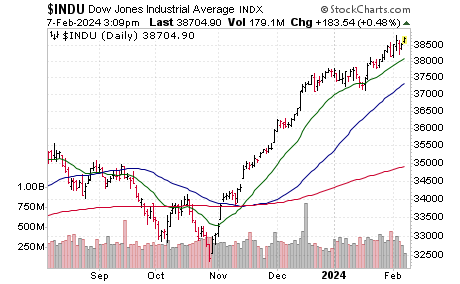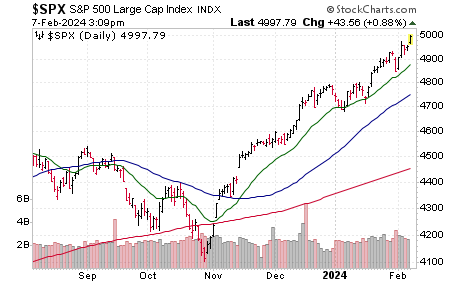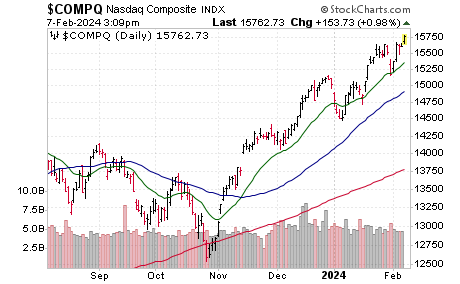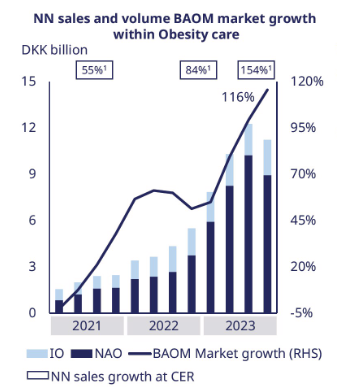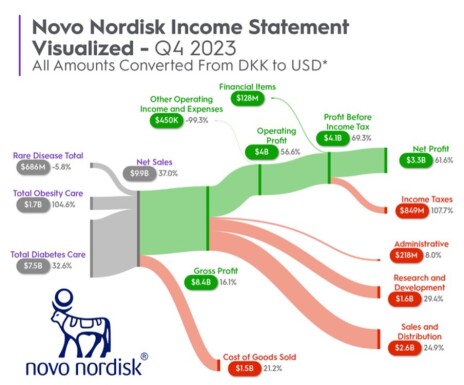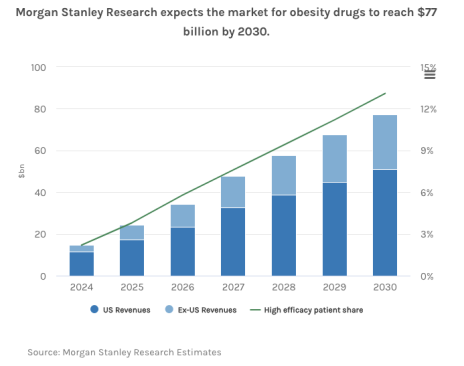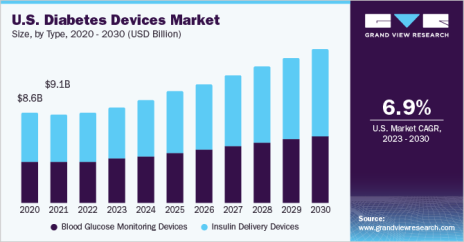The markets have continued their bullish momentum so far in 2024, with growth stocks continuing to lead the way—especially large caps, which are up 32.94% so far this year.
Sector-wise, Communication Services (up 9.74%), Technology (up 5.07%), and Healthcare (up 4.11%) are the winners so far, with Real Estate (down 4.37%), Utilities (-2.91%), and Consumer Discretionary (-0/83%) the losing sectors.
Housing inventory is still tight, with prices remaining a little lofty. The S&P Case-Shiller home price index came in at a 5.4% rise, which was a bit less than the 5.7% forecast, but still higher than the month before.
The economy seems to be rolling along nicely. Inflation is 3.4%, a considerable decline from 2022’s high of 9%. Job openings are steady, the unemployment rate remained at 3.7%, and consumer confidence rose to 114.8, up from 108.0.
The Federal Reserve left interest rates alone but somewhat roiled the markets when Chairman Jerome Powell didn’t seem to be in any hurry to begin lowering them.
Here at Cabot, we remain bullish, but suggest you keep some cash on the sidelines, just in case.
Feature Recommendation
Novo Nordisk A/S (NVO): Revolutionizing the Weight-Loss and Obesity Markets
Recommended by Mike Cintolo, Chief Analyst, Cabot Growth Investor and Cabot Top Ten Trader
Growth stocks had a banner year in 2023, and so far in 2024, they are still going gangbusters! With that in mind, I asked our growth expert, Mike Cintolo, for some growth ideas. Here is what he had to say:
“Novo Nordisk (NVO), stock-wise, is mostly about Wegovy, one of the two big diabetes/weight loss drugs on the market that could become the biggest sellers in history. (Eli Lilly (LLY) has the other.) The valuation is up there, but it’s obviously a unique situation, and after three months of mostly chopping around, NVO is back at new highs.
“The exploding weight-loss market is thanks in part to the breakthrough treatment from Danish pharma giant Novo Nordisk. Semaglutide, its GLP-1 hormone-mimicking drug marketed under various names including Wegovy (weight loss) and Ozempic (diabetes), has helped to create multi-billion-dollar markets in those two huge end markets.
“While the company isn’t the only one with a GLP-1 drug now (a competitor from Eli Lilly was greenlit in the U.S. in November), Novo Nordisk is obviously one of the big players.
“For 2023, currency-neutral sales are expected to have risen 35% to about $33.3 billion, while operating profit likely rose 45%. The boom in semaglutide has Novo Nordisk awash in cash too (north of $10 billion cash flow expected for all of the year), which bodes well for the company being able to fund new applications of its drugs.
“Management is pursuing new bastions of semaglutide for expanded diabetes and obesity treatments, as well as for promising combination therapies that may address Alzheimer’s and non-alcoholic steatohepatitis. For instance, Wegovy, currently used as a weekly injection, is also proving effective in trials in pill form.
“The biggest problem for Novo Nordisk lately is simply being able to meet semaglutide demand. About 40% of Americans are obese, leading physicians to throttle back prescriptions to ensure those needing it most (especially diabetes patients) have ample supply. That will tamp growth near term, but analysts still see sales rising 21% and net income at a slightly faster clip this year (and the firm has a history of topping conservative assumptions).
“Novo Nordisk isn’t just weight loss—it has a pipeline of blood and heart drugs in trials and has been acquiring other companies to diversify the business into blood pressure and receptor-based therapies. Even so, the stock is very likely to trade based on semaglutide trends, with many thinking it (and competing products like Lilly’s) could be the biggest sellers ever.
“NVO’s long-term chart is marked by a steady uptrend with strong buying periods followed by orderly consolidations as business has improved. The stock saw a huge positive reaction to earnings in August, though the action since then has been choppy, with higher highs and higher lows, but not a ton of net progress. That’s not to say the action has been poor, though. In fact, the stock has tagged new price highs on good volume.
“We’re OK with a small buy here, and possibly adding if the buying pressures pick up. Buy.”
Although now Novo has competition in the obesity space, you can see how this niche has exploded for the business in the past few years (with no signs of abating!)
The shares are spiking for Novo Nordisk following the company’s earnings report a few days ago. Novo Nordisk beat earnings for the fourth quarter of 2023 and the full year, and the company’s valuation surged above $500 billion, making it the most valuable company in Europe!
For the fourth quarter, total sales jumped 39%, to $9.58 billion (ahead of the analysts’ $9.15 billion forecast) thanks to Ozempic revenues climbing 79% year over year to about $4.37 billion and Wegovy’s sales almost quadrupling to $1.4 billion.
Adjusted earnings rose 65%, to $0.71, also beating the $0.67 Wall Street had predicted. The company also boosted its semi-annual dividend to $0.664 per share.
The shares of Novo Nordisk got a further boost upon the company’s announcement that it would purchase contract drug manufacturer Catalent (CTLT) for $16.5 billion. The deal includes three manufacturing plants in the U.S., Belgium, and Italy that will make Novo’s GLP-1 drugs Ozempic and Wegovy.
I agree with Mike. Obesity and diabetes aren’t going away; buy.
Novo Nordisk A/S (NVO)
52-Week Low/High: $ 67.66 - 118.32 Shares Outstanding: 4.46 billion Institutionally Owned: 9.02% Market Capitalization: $ 522.007 billion Dividend Yield: 0.91% https://www.novonordisk.com | Why Novo Nordisk:
Owns almost a third of Leading market positions in diabetes, obesity, and hemophilia Solid patent protection (until the 2030s and beyond) Strategic acquisitions add to both top and bottom lines Semi-annual dividend just boosted |
About the Analyst: Mike Cintolo, Chief Analyst, Cabot Growth Investor and Cabot Top Ten Trader
A growth stock and market timing expert, Michael Cintolo is chief analyst of Cabot Growth Investor and Cabot Top Ten Trader. Since joining Cabot in 1999, Mike has uncovered exceptional growth stocks and helped to create new tools and rules for buying and selling stocks. Perhaps most notable was his development of the proprietary trend-following market timing system, Cabot Tides, which has helped Cabot place among the top handful of market-timing newsletters numerous times.
I had a chance to catch up with Mike to get his current outlook. Mike always says he doesn’t have a crystal ball, so he doesn’t make market predictions. But he has an uncanny knack for reading market trends. Here’s our interview:
Nancy: Inflation has declined to 2.9%, but the Fed has signaled that it’s not quite ready to begin cutting rates. So far, the markets don’t seem to be too happy with the delay. Do you think this hesitation will stop the recent bullish temperament of the market? Why or why not?
Mike: Well, I’m not a super-macro guy, but there’s no doubt rates and the Fed have been the tail that has wagged the stock market the past two years. I do think there’s a chance that the market is ready to digest its strong November-January run, and the Fed not being as easy as the market would like provides a nice excuse for that (along with some re-emerging issues, it seems, with regional banks).
Nancy: Your Cabot Top Ten Trader has a nicely diversified portfolio, and your Cabot Growth Investor seems to be more skewed toward tech stocks, but still owns some non-tech names.
Mike: Yes, Growth Investor is, well, growth. We do go in different areas if we think they can trend, but so far, technology has been where it’s at for growth. Ideally, we’ll see more medical, biotech, retail, and the like kick into gear later, but so far, we’re going with what works.
Top Ten, on the other hand, just goes for wherever the strength is. Thus, while there’s plenty of tech, there’s also been plenty of construction and housing, a few commodities here and there, some “turnaround” retail and the like. Again, it’s just based on what’s working, which is a big advantage of the advisory.
Nancy: I believe that you are a more technical analyst than fundamental, so is the diversification just sort of a happy accident due to the stocks’ momentum, or did you deliberately diversify your portfolios?
Mike: Well, while charts are key to my work, I do spend a lot of time on fundamental digging. And yes, I’m a bit leery of having too many name that swim together, especially as Growth Investor is a concentrated portfolio (usually no more than 10 to 12 stocks). I don’t diversify in the normal way—small cap, mid-cap, international, all that—but I don’t need three chip stocks, for instance, aiming to own the one true leader in every leading group.
Nancy: Would you please share with my subscribers which particular parameters you think are the most important factors in determining the future potential of a stock?
Mike: Fundamentally, I use what I loosely term the 3 Rs: rapid and reliable growth, and a long runway of growth. The combination of all three is like catnip for big, institutional investors, who are the ones driving things. If you combine that with a chart that’s generally under accumulation—I’m not a bottom fisher, but a trend follower—and a market that’s in gear on the upside, you can score some bigger winners.
Nancy: Tech, Communication, and Healthcare sectors all seem to be continuing to fly high since the beginning of 2024. Do you see any reason why they can’t continue that trend for the next few months?
Mike: I don’t really play the guessing game, but I am fairly optimistic that, after two-plus years of growth stock sourness, that 2024 can be a good year for my kinds of stocks (glamour-type names, not mega-cap names). Thus, I do think it can continue, though near-term, I also half-expect some turbulence after the recent run.
Nancy: Do you see any sectors or sub-sectors that you currently think are oversold?
Mike: I’m not an oversold guy, but I am watching retail, which usually launches a few winners, and solar, which has been one of the worst sectors out there (though one name just broke out on earnings, so maybe it can lead the way higher). I guess to answer your question, I’m keeping my eyes open for some rotation where maybe some tech stuff rests but other areas break out and run.
Like I mentioned above, I’m half-expecting some turbulence in some extended stocks, but what’s encouraging is that I’m seeing some big earnings gaps on huge volume as well.
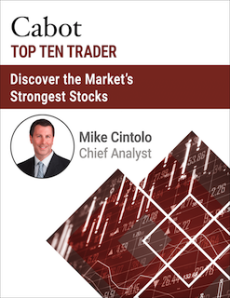
Learn More

Learn More

Learn More

Learn More
Portfolio Updates
Tom Hutchinson, Chief Analyst of Cabot Dividend Investor, recently updated his take on Qualcomm Inc. (QCOM), saying, “QCOM is starting off the year strong. It went up about 10% in just a few days to a new 52-week high last week and approached the highest level since early 2022. The recent catalyst is that semiconductor companies that have reported earnings are confirming that the semiconductor industry has double-digit growth this year after contracting last year.
“Leaders like Qualcomm should experience a much higher level of growth than the overall industry. Qualcomm reports earnings later this week. Hopefully, it will be good news that helps the stock break out from here. Qualcomm is introducing new AI chips for PCs and smartphones that could be big sellers this year. BUY.”
The Semiconductor Industry Association echoes Tom’s prediction for growth, predicting “record” growth, in fact, up to $600 billion.
In its most recent quarter, the company reported a 5% increase in revenue, to $9.9 billion, beating analysts’ estimates by 4.3%. Earnings also beat, up 25% to $2.46 per share.
Revenues were helped by a 31% jump in automotive sales, and handsets also rose by 16%, as a result of the success of the company’s Snapdragon platforms.
Looking forward, QCOM expects second fiscal quarter sales between $8.9 and $9.7 billion, and Non-GAAP diluted EPS around $2.20 - $2.40.
Continue to Buy.
Bruce Kaser, Chief Analyst of Cabot Value Investor and Cabot Turnaround Letter, reported on Citigroup (C), noting, “On Friday, January 12, Citi reported a highly scrubbed but reasonable quarter. Scrubbed revenues rose 2% while scrubbed earnings fell 24%.
“The Services segment and the U.S. Personal Banking business produced strong results, but Markets and Banking results were sloppy, and the Wealth segment was weak. CEO Fraser said that the new five-segment structure is now in place and that “2024 will be a turning point” for the transformation, although 2024 guidance seems a bit optimistic.
“Capital and credit remain healthy while deposits and loans were reasonably steady. Citi has set aggressive revenue and cost-cutting targets as CEO Fraser has stepped up her massive full-company overhaul. The shares trade at 60% of the updated tangible book value of $86.19/share, as investors have little confidence in a favorable outcome. The dividend appears solid, and Citi repurchased about $500 million of shares in the quarter, indicating that management and regulators have some elevated degree of confidence in Citi’s capital level and capital generation. No change to our rating. Buy.”
“When comparing Citi shares with a U.S. 10-year Treasury bond, Citi offers about the same yield and considerably more upside price potential. Clearly, the Citi share price and dividend payout carry considerably more risk than a Treasury bond, but at the current valuation, Citi shares would seem to have a remarkably better risk/return trade-off. BUY.”
Hedge funds are sniffing at the shares of Citi, with 79 now holding shares, up from 75 in the previous quarter. Continue to Buy.
Curaleaf (CURLF) and the cannabis industry were updated by Michael Brush, Chief Analyst of Cabot Cannabis Investor, who noted, “Cannabis stocks got moving earlier this year when the Health and Human Services Department (HHS) released documents supporting the major federal level cannabis reform that it wants to see.
“The next step in rescheduling will come in the form of a proposed rescheduling rule from the DEA. The timing is critical. It has to happen by March or April, for the Biden administration to reap election-year boasting rights.
“Some recent poll results suggest the Biden administration is likely to press hard for progress on cannabis rescheduling as an election tactic. The two key trends in the polls for cannabis investors are 1) a vast majority of voters back cannabis reform, and 2) cannabis reform is an even more salient issue for young voters.
“The bottom line: Given the way younger voters are defecting to the right, you can imagine the Biden camp may be pushing hard for timely progress on cannabis rescheduling. The poll results suggest a DEA proposed rule could drop soon, catalyzing the cannabis sector once again.
“Curaleaf in early January launched a fast-acting THC beverage mix called Stir. Stir packets contain liquid with 5mg of THC designed to be mixed with drinks like sparkling water. Stir joins Curaleaf’s Zero Proof line of THC mixes. The company says the product uses nanotechnology to help it provide an effect in 15 to 30 minutes. Edibles often take twice as long.
“’Stir by Zero Proof is the next step in expanding our portfolio of THC-infused drinkables, a category which we believe will ultimately redefine how people socialize,’” said CEO Matt Darin. Stir is available in Illinois.”
The company is set to open a recreational-use store in Hudson Valley, New York, the first rec-use operation in the state. It has been a medical-use dispensary since 2017, and Curaleaf is expanding it to accommodate rec-use sales. Continue to Hold.
Tyler Laundon, Chief Analyst for Cabot Early Opportunities and Cabot Small-Cap Confidential, had this to say about TransMedics Group (TMDX): “Last year, TransMedics acquired an aviation business so it can control even more of the organ transplant supply chain. This is a major initiative, and initial uncertainty from investors has become cautious optimism given the most recent quarterly report and future potential. Not to mention international expansion opportunities. Shares have been making a series of higher highs and higher lows since the Q3 report in early November. Suffice it to say the next report is a big one. Investors are now back to expecting great things from the aviation business. HOLD A QUARTER.”
In a recent report, it was noted that about 15,000 organ and tissue donors die each year, and just a fraction of the total available organs are actually transplanted. Those sorry statistics are what is driving the share price of the company—which has more than doubled since last August.
The company is due to report earnings on February 20, with analysts expecting a loss of $0.03 per share on revenues of $68.51 million. Continue to Hold.
Tom Hutchinson also reported on Brookfield Infrastructure Partners (BIP), saying, “Like many other safe dividend stocks, BIP had a strong resurgence at the end of last year as interest rates peaked. But unlike most of these stocks, BIP has held very steady during what has been an ugly January for defensive dividend stocks. It is still a great stock at a cheap price. The high distribution and highly reliable infrastructure earnings are still much desired. It looks like 2024 should be a great year that makes up for some lost time. The partnership reports earnings on Thursday that can hopefully spur a breakout from here. (This security generates a K-1 form at tax time). BUY.”
We’ve seen some nice movement in the shares of Brookfield since its August lows. Hard to say why the market isn’t valuing it at a loftier price. After all, the company grew its funds from operations (FFO) by 10% last year and increased its dividend by 6%.
And Brookfield is in acquisition mode, acquiring 40 data sites out of bankruptcy from Cyxtera, and buying American Tower’s (AMT) Indian operations (78,000 towers). Continue to Buy.
Bruce Kaser, Chief Analyst of Cabot Value Investor and Cabot Turnaround Letter, noted that “the consensus view on NOV, Inc (NOV) is overly pessimistic, given the company’s strong position in an industry with improving conditions, backed by capable company leadership and a conservative balance sheet. BUY.”
NOV reported that revenues in its most recent quarter came in at $8.6 billion, in line with estimates, but EPS was 77% above analysts’ estimates, a healthy $2.50.
For 2024, Wall Street is forecasting revenues of $9.17 billion for the company. But their predictions for EPS have been tempered, to $1.49 from earlier estimates of $1.72.
But having said that, analysts are still setting the company’s share price target at around 25, a nice increase from current prices. Continue to Buy.
Our recommendation of International Business Machines (IBM) was updated by Carl Delfeld, Chief Analyst of Cabot Explorer. Carl noted, “Shares gave back a bit this week but over the last month have shot up from 161 to 183. After strong quarterly earnings and cash flow, the stock is benefiting from a sharp uptick in demand for its hybrid AI and cloud computing services. Buy a Half.”
This seasoned company is making new waves in artificial intelligence, recently releasing watsonx.governance, a tool for AI compliance protocols, which is already being used by large businesses such as Deloitte.
On its quarterly conference call, the company’s CEO said, “We continue to believe our consulting business will be an early beneficiary of AI. We are the only provider today that offers both a technology stack with our watsonx platform and consulting services for deploying and managing generative AI.” Continue to Buy.
Bruce Kaser also updated his take on Gates Industrial Corp, plc (GTES): “The company produces wide EBITDA margins, has reasonable debt balances and generates considerable free cash flow. The management is high-quality.
“Gates shares rose 1% in the past week and have 23% upside to our 16 price target. BUY.”
Gates will report earnings on February 8. Analysts are expecting EPS of $0.28 on revenues of $862.89 million. Continue to Buy.
Tom Hutchinson also updated UnitedHealth Group Inc. (UNH), noting, “This healthcare insurer has been sucking wind lately. It’s down over 7% since the end of November and Wall Street didn’t like its fourth-quarter earnings reports.
“The company reported double-digit earnings and revenue growth, but costs were higher than expected. The reasons were more elective surgeries after Covid, extra vaccine activity, and inflation. But the company doesn’t expect costs to have a negative impact on 2024 projections. The higher costs are likely temporary and can be easily overcome. It’s a good entry point if you don’t own UNH already. BUY.”
The company is still forecasting its long-term profits will grow between 13% and 16% per year, due primarily to Medicare revenues. Its latest earnings report supported that premise, with revenues expanding 14%, to $32.4 billion.
I agree with Tom. Continue to Buy.
Carl Delfeld had this to say about Exscientia (EXAI): “Shares were steady this week as this AI-driven biotechnology company continues to partner with mega-drug companies to launch new products. Exscientia stock is trading way off its high in an uptrend at 5.89. It went public at 22 a share so the company has about $500 million in cash on the books—a big number for a company with a market capitalization of just $733 million. Finally, keep in mind that this is an attractive speculative stock which may have a bumpy ride. It is a young company that is not and will not be profitable this year. Buy a Half.”
Wall Street is a believer in EXAI, with 75% of the company’s analysts recommending either a “buy” or “strong buy.” The average analysts’ price target for EXAI is 8.67 per share, which would be a nice gain for us! Continue to Buy.
Portfolio
| Company | Symbol | Date Bought | Price Bought | Price on 2/7/24 | Gain/ Loss % | Rating | Risk Tolerance |
| M | |||||||
| M | |||||||
| A | |||||||
| EXAI | A | ||||||
| GTES | M | ||||||
| M | |||||||
| NOV | 6/8/23 | M | |||||
| NVO | NEW | A | |||||
| QCOM | 7/15/22 | M | |||||
| TMDX | |||||||
*Aggressive (A), Moderate (M), Conservative (C)
ETF Strategies
Most of our ETFs remain in the black, with seven positions up by double-digits: Communication Services Select Sector SPDR Fund (XLC, up 39.47%), iShares US Energy (IYE, up 20.13%), First Trust Water ETF (FIW, up 20.55%), Invesco Semiconductors ETF (PSI, up 17.22%), iShares Russell Top 200 ETF (IWL, up 14.34%), Vanguard Dividend Appreciation Index Fund (VIG, up 11.41%), Vanguard U.S. Momentum Factor ETF (VFMO, up 14.87%), and ALPS Medical Breakthroughs ETF (SBIO, up 19.06%)
Our Watch List has two names remaining:
GX U.S. Infrastructure Development ETF (PAVE)
Vanguard Small Cap Growth Index Fund (VBK)
Drugs Addressing the Obesity and Diabetes Markets Have the Power to Radically Change Lives and Profits!
The World Health Organization reports that more than 750 million people are obese, leading to 5% of global deaths. In the U.S., the obesity rate has climbed to 41.9%.
Fortunately, the new weight loss drugs, such as those patented by Novo Nordisk, are addressing what is a fantastically growing market. Some 40 million out of 110 million obese adults are accessing these treatments already. That’s pretty amazing, considering that the monthly nut for these drugs runs around $1,000!
So far, most insurance companies will not reimburse for obesity drugs unless they are determined to be medically necessary. Medicare, by law, does not reimburse; however, there is a bipartisan effort to change that currently in the works.
DataHorizzon Research estimates that the weight loss drugs market was about $1.9 billion in 2022, but is forecast to grow to $82.8 Billion by 2032, a CAGR of 45.7%.
But as Mike said, Novo’s GLP-1 drugs are also being used for diabetes treatment, another disease that is rapidly on the rise worldwide. Those suffering from diabetes are finding that weight management combined with blood-sugar control are proving effective treatments of the disease.
The American Diabetes Association reports that 38.4 million Americans, or 11.6% of the population, has diabetes, with about 23% currently undiagnosed. Worldwide, an estimated half a billion people are suffering from diabetes, and that is expected to expand to 1.3 billion in the next 30 years.
And diabetes is the second growing market for the obesity drugs that Novo and its competition will service.
Globally, the diabetes drugs market size was valued at $79.25 billion in 2023, and is forecast to grow to $134.08 billion by 2030.
| Aspects | Details |
Market Size By 2030 | USD 134.08 billion |
Growth Rate | CAGR of 10.4% |
Forecast period | 2020 - 2030 |
Report Pages | 160 |
By Product |
|
By Region | North America (U.S., Canada, Mexico) Europe (Germany, France, United Kingdom, Italy, Spain, Rest of Europe) Asia-Pacific (China, Japan, India, Australia, Rest Of Asia Pacific) LAMEA (Brazil, Saudi Arabia, South Africa, Rest of LAMEA) |
Key Market Players | Takeda Pharmaceutical Company Limited, Merck And Co., Inc., Astrazeneca Plc, Novo Nordisk, Boehringer Ingelheim Gmbh, Novartis Ag, Johnson And Johnson MD&D, Glaxosmithkline Plc, Eli Lilly And Company, Sanofi S.A. |
Source: Alliedmarketresearch.com
The largest companies in the diabetes drugs market are Novo Nordisk A/S (Denmark), Sanofi (France), Merck & Co., Inc. (U.S.), and Eli Lilly and Company (U.S.).
While the growth of obesity and diabetes is staggering, the new drugs are going to help change millions of lives, and the companies like Novo Nordisk who are the pioneers will continue to profit. Of course, competition is rising, and the supply shortages and insurance reimbursement issues have caused some near-term challenges, but long-term, we can expect a vastly expanding market.
Portfolio
| Company | Symbol | Risk Tolerance* | Recommendation | Date Bought | Price Bought | Price on 2/7/24 | Gain/ Loss % |
*Aggressive (A), Moderate (M), Conservative (C)
**Purchase price reflects a 3-for-1 stock split
The next Cabot Money Club Stock of the Month issue will be
published on March 14, 2024.
Copyright © 2024. All rights reserved. Copying or electronic transmission of this information without permission is a violation of copyright law. For the protection of our subscribers, copyright violations will result in immediate termination of all subscriptions without refund. Disclosures: Cabot Wealth Network exists to serve you, our readers. We derive 100% of our revenue, or close to it, from selling subscriptions to our publications. Neither Cabot Wealth Network nor our employees are compensated in any way by the companies whose stocks we recommend or providers of associated financial services. Employees of Cabot Wealth Network may own some of the stocks recommended by our advisory services. Disclaimer: Sources of information are believed to be reliable but they are not guaranteed to be complete or error-free. Recommendations, opinions or suggestions are given with the understanding that subscribers acting on information assume all risks involved. Buy/Sell Recommendations: are made in regular issues, updates, or alerts by email and on the private subscriber website. Subscribers agree to adhere to all terms and conditions which can be found on CabotWealth.com and are subject to change. Violations will result in termination of all subscriptions without refund in addition to any civil and criminal penalties available under the law.

